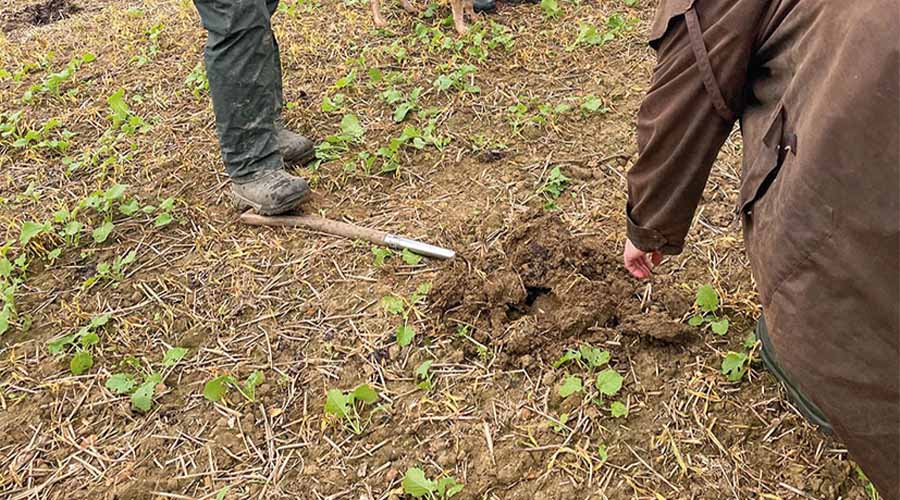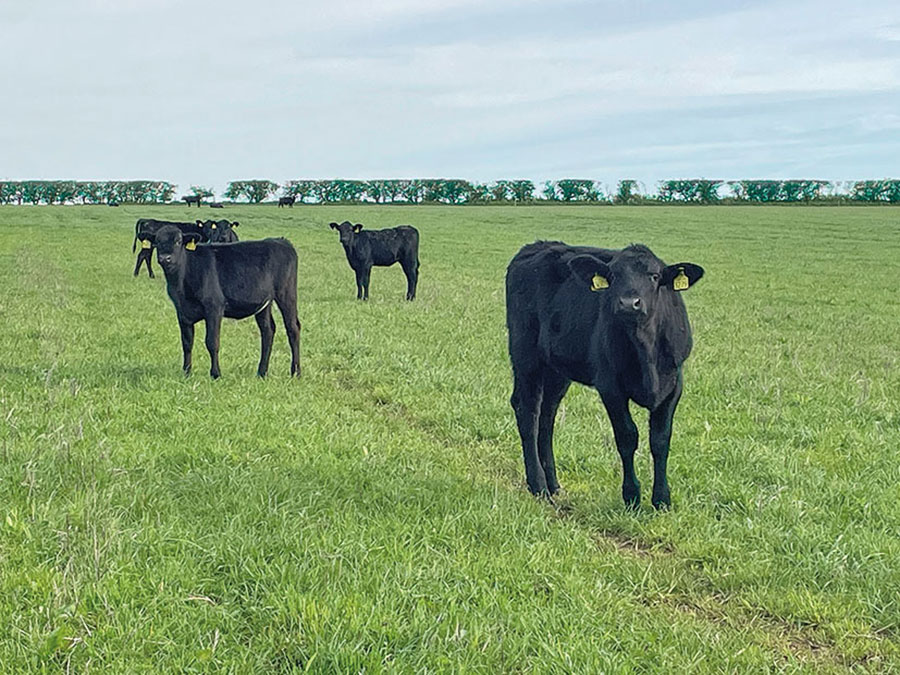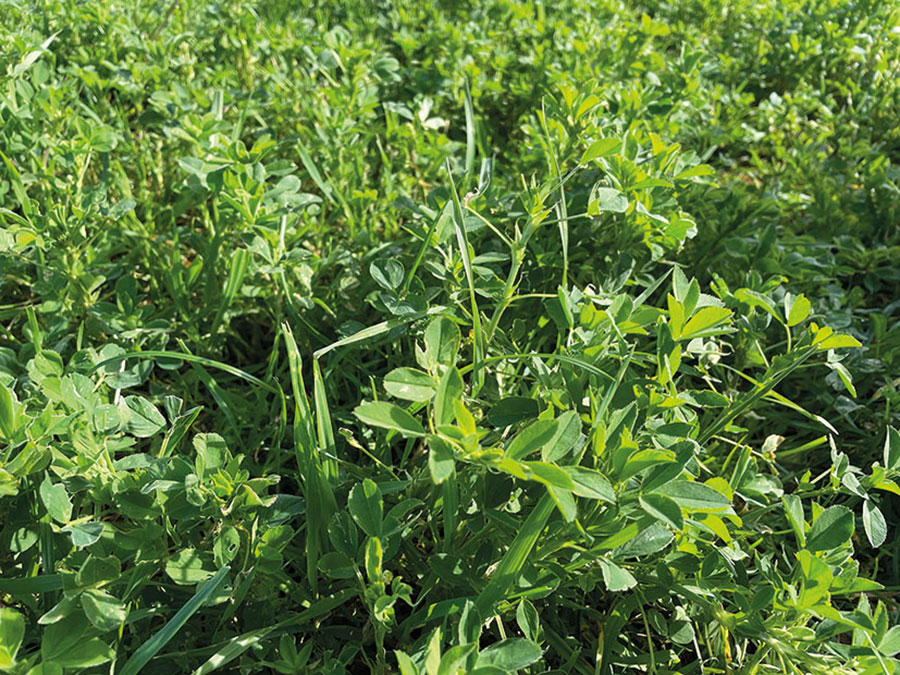What lies beneath? One farmer’s quest to improve his soil health
2nd May 2024
It’s all change for Norfolk farmer David Cross as he works to explore the potential of livestock grazing to restore soil health. Sarah Juggins writes.

David Cross is a tenant farmer in North Norfolk, farming 550ha of soil that is predominantly light alkaline soils and chalk. It is soil that has been farmed for sugar beet, potatoes and cereals for decades and is, in David’s words, “very tired”.
Four years ago, David recognised that his farming practices had to change as you could see topsoil being lost from the fields as more chalk was becoming visible. However, rent had to be paid and his family supported so it wasn’t about stopping farming, but focusing more on the soil. He has a strong livestock background and wanted to make the most of these skills.
All the literature that David – a curious and knowledge-hungry farmer – was reading told him that there had to be a better way than simply increasing the amount of fertiliser or plant protection products (PPP) he was adding to the soil. Like so many farmers, he was in the unrelenting cycle of adding more and more chemicals to the soil to achieve a profitable crop. Somehow that cycle needed to be broken and the soil needed to regain some function. The holy grail was a low input, high output system. But how to achieve this?
Radical change
In a bold move, he decided to change his farming system totally. He is now in his final year of growing potatoes and cereals are to be taken out of the rotation. From next year, most fields will be in herbal leys with most sub-divided for paddock grazing.
The arable farm that had previously had a herd of sheep and a small finisher herd of beef cattle is now transitioning into a farm that will grow forage for a mixed bag of livestock including a much larger number of sheep and lambs and a native breed suckler cow herd. Two mobile chicken huts have been installed that will be producing eggs from June. In a nod to traditional mixed farming, the hens will graze on the pasture, following the sheep – a recognised way of improving pasture for livestock and soil health.
“This transition was only made possible by Countryside Stewardship schemes,” David says. “By taking advantage of the Countryside Stewardship payments available for grassland improvement and including herb and legumes within an arable rotation; and by tapping into the equipment fund, I could re-seed the farm, fence the fields and add water pipes so that I could easily move livestock around the farm.
“We used capital works grants to put the infrastructure in place. This included putting a permanent fence in and using temporary fencing to divide fields into smaller grazing parcels.”
The result is a deceptively simple series of grazing areas that are divided by temporary electric fencing, with a permanent perimeter fence enclosing the entire grazed area. Using a mapping app, David can set out his grazing plan and anyone moving the fencing can easily see where the grazing line needs to be moved to. This allows for an easily managed mob grazing system.
Steadying the finances
When considering his options, David decided upon five goals and objectives which would form the basis of the way he will farm for at least the next five years:
- Improve soil health and increase organic matter
- Improve stock performance (growth rates, numbers of lambs and margin per hectare)
- Increase pasture yield without using nitrogen
- Introduce a native breed suckler cow enterprise to help with pasture quality and create direct selling opportunities
- Maintain a collaborative mindset.
To transition from an arable rotation to a livestock enterprise does challenge the established cash flow. David explains that he is using GS4 payments to steady the finances during the transition.
“Currently half the farm is in multi species leys and another 45% will go into this in the next eight months. At the same time, we will be moving from a heavy cash flow period in the autumn to spring and winter cash flow. None of this would have been possible without government schemes. And we all know that these can be very short term, so it was important to use them while they were available.”
Asked what persuaded him to change the way things had always been done, David said: “It really was the only option I could see. We couldn’t continue if the majority of our income was meant to come from cereals.”
A closer look at soil health
So, infrastructure in place and clear goals and objectives identified, David is making the leap from conventional agriculture into something that his grandfather would have recognised – a farm in which livestock are playing a key and integral role. His hope is that in a few years’ time he will be rewarded for taking the risk with healthy soil and a thriving livestock business.

This is where Liz Genever enters the scene.
Liz is a beef and sheep consultant and farmer from Lincolnshire. She has long been interested in using livestock to increase soil health, largely through Carbon Calling, a social enterprise seeking to spark curiosity about how farming can be done differently. She is also one of just 23 people who are currently taking part in the Create UK course, which is run by internationally renowned agroecologist Nicole Masters, founder of Integrity Soils.
The Lincolnshire farmer has long been a believer that all farms should have livestock within the system. Whether that is operating as a mixed farm or whether it is working with graziers and shepherds to bring livestock onto the land for periods of the year.
“It is exciting to work with Dave as the speed of change he is able to achieve is very impressive,” says Liz. “He has trialed lots of things, and decisions are being based on data and experience.”
Working together, and supported by the AHDB as one of its monitor farms, Liz and David identified four fields. One was an arable field, one was a third-year herbal ley, another was a second-year herbal ley and the fourth was a first-year herbal ley. The Soilmentor app was used to record data from each field.
Even in these early stages of transformation, some of the results were unassailable. The arable field had a marked absence of soil’s engineers – earth worms; water infiltration rates were much higher in the arable field, suggesting that the soil was compacted; the rooting depth of plants was low and there were no rhizosheaths, which indicate that the roots are leaking sugar.
That said, there is still a long way to go even with the soils that are now benefiting from a permanent cover crop in the form of herbal ley. Liz points out that context is everything and, additionally, these soils have been hammered over the years.
Organic matter in the four fields ranged from 2.8% (second-year herbal leys) to 3.6% (third-year herbal leys). And the pH ranged from 6.9 (third-year herbal ley) to 7.3 (arable). When it came to the soil’s ability to hold nutrients, known as the Cation Exchange Capacity, David’s scores across all four fields was in the medium bracket; i.e. room for improvement.
When it came to the main elements, magnesium and hydrogen levels were exceptionally low, aluminum was also low, calcium at 84–91% was way above target of 63.5%, while potassium and sodium levels were in the correct range.
The challenge that ongoing results are throwing up for Liz and David is how to get all the soil chemistry functioning so that the nutrient store is well-balanced across all the main elements. Soil biology has a part to play in this.
Potential solutions
One of the answers lies in the presence of fungi. Not only does fungi stabilise soil aggregates, it is also needed to increase the availability of phosphate and other minerals. Currently, the high levels of calcium in the soil means phosphate, along with boron, magnesium, manganese and zinc all suffer reduced availability.

But of course, it is not just fungi that is an essential component of soil health. Samples were sent off to Nick Padwick at Wilder Soils for a soil food web assessment to look for bacteria, fungi, protozoa and nematode levels. The results showed that the soils were bacteria dominated, which links to the history of fields.
Which leads to the question of how changing the farming practice can lead to improvements in soil health on the farm?
For this, Liz points to the six principles of soil health, which are based on Gabe Brown’s ’Five Principles with one addition – Know Your Context.
In his seminal work Dirt to Soil, US regenerative agriculture specialist Gabe Brown outlines five principles to improve soil health: Limit disturbance; cover the soil (armour the soil); build diversity; keep living roots in the soil and integrate animals. Liz and her colleagues on the Create course would add the importance of a farmer knowing his or her land and hence knowing the context of the soil.
His mind may be reeling from the risks he is taking but by giving his soils a chance to rest, David is allowing regeneration to happen beneath the surface.
Read more arable news



